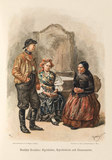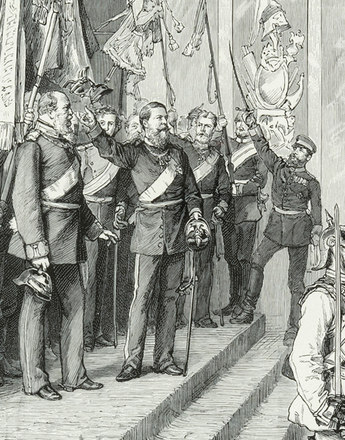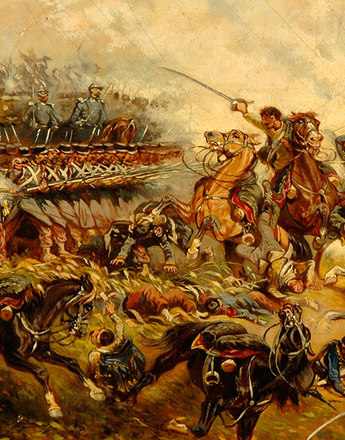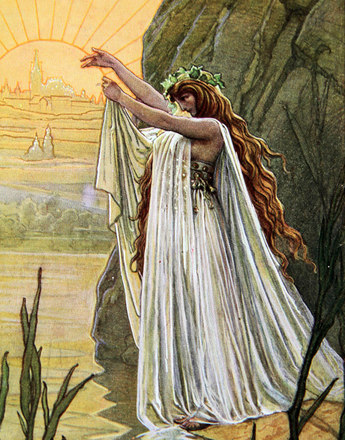The drive for unification
-

Rudolf v. Ottenfeld: German costumes from Bohemia: A man and a woman from the Egerland and a woman from Braunau, illustration
Copyright: Schloß Schönbrunn Kultur-und Betriebsges.m.b.H./Fotograf: Alexander E. Koller
-

Roman Kochanowski: The Vavel, the Royal Castle in Kraków, illustration
Copyright: Schloß Schönbrunn Kultur-und Betriebsges.m.b.H./Fotograf: Alexander E. Koller
As well as differing in their language and sense of national identity, the nationalities of the Habsburg multi-ethnic state also differed with respect to their areas of settlement. While some groups lived entirely within the Habsburg Monarchy, others were spread across the borders. In some cases this factor had considerable influence on historical developments.
The peoples whose areas of settlement were exclusively on Habsburg territory included the Magyars, the Czechs, the Slovaks, the Slovenes and the Croats. Accordingly, their process of rising to nationhood took place within the framework of the Habsburg Monarchy.
Other ethnic groups were settled in areas divided by state borders, with the result that those living on Habsburg territory had co-nationals outside the Monarchy – which in the age of the rise to nationhood was a complicating factor of considerable importance.
The area of settlement of the Poles, for example, had been shared out between three states at the Partitions of 1772 and 1795 in which the state of Poland had disappeared from the map of Europe; since then there had been Poles living not only on Habsburg territory but also in Prussia (later German Empire) and in Russia. In the case of the Ukrainians, the majority of the ethnic group were governed by Russia and a minority by the Habsburgs.
Likewise, only a small proportion of the Serbs and Romanians lived on Habsburg territory, and their core areas of settlement had long been in the sphere of Ottoman influence. Both peoples took advantage of the decline of the Ottoman Empire to advance their national emancipation and advance to independent statehood, with the young nation-states of Serbia and Romania eagerly posing as the protectors of their co-nationals living under Habsburg rule.
The situation of the Habsburg Monarchy’s German- and Italian-speaking subjects was even more complicated. Both groups enjoyed a privileged position as compared with the other nationalities under Habsburg rule. Not only had the German-Austrians long been the numerically dominant ethnic group, but even after the Compromise of 1867 they had still been able to preserve their leading position in many fields, at least in the Austrian half of the Monarchy. As for the Italians, after the Habsburgs had lost the provinces of Lombardy and Venetia, they were numerically only a small group in the Monarchy but nevertheless still politically and socio-economically superior to the other nationalities in their area.
For Germans and Italians alike, the section of the ethnic or language group settled in the Monarchy was far smaller than the section outside, and in both cases it was the latter group that was to play the leading role in the rise to nationhood and the final creation of the unified German (1871) and Italian (1861–1870) nation-states.
Both new states – Germany and Italy – were formed independently of their respective co-nationals within the Habsburg Monarchy. Subsequently these German and Italian Habsburg subjects developed separatist tendencies that shook the territorial integrity of the Habsburg Monarchy to its very foundations; finally – especially in the case of the Germans – these separatist tendencies were to be amongst the principal causes of the growth of instability under Emperor Franz Joseph.
Translation: Peter John Nicholson
Kann, Robert A.: Zur Problematik der Nationalitätenfrage in der Habsburgermonarchie 1848–1918, in: Wandruszka, Adam/Urbanitsch, Peter (Hrsg.): Die Habsburgermonarchie 1848–1918, Band III: Die Völker des Reiches, Wien 1980, Teilband 2, 1304–1338
Křen, Jan: Dvě století střední Evropy [Zwei Jahrhunderte Mitteleuropas], Praha 2005
Rumpler, Helmut: Eine Chance für Mitteleuropa. Bürgerliche Emanzipation und Staatsverfall in der Habsburgermonarchie [Österreichische Geschichte 1804–1914, hrsg. von Herwig Wolfram], Wien 2005
-
Chapters
- The birth of nations
- The hierarchy of languages
- ‘Tell me what language you speak and I will tell you who you are.’
- Unity in diversity? The failure of the idea of a ‘greater Austrian’ nation
- The role of history: Concerning ‘historic’ and ‘history-less’ peoples
- The drive for unification
- The role of schools in the growth of national identity
-
Chapters
- The drive for unification
- The radical German nationalists and their attitude to the Habsburg Monarchy
- The concept of ‘German Central Europe’
- Together we are strong: Pan-slavism and "Slavdom"
- The rise and fall of Austro-Slavism
- "Two branches of one nation" – Czechoslovakism as a political programme
- Viva l’Italia! Italian irredentism and the Habsburg Monarchy
- From Illyrism to Yugoslavism: competing concepts for a southern Slav nation
- Élyen a Magyar – long live the Magyars! Hungarian Magyarization policy





